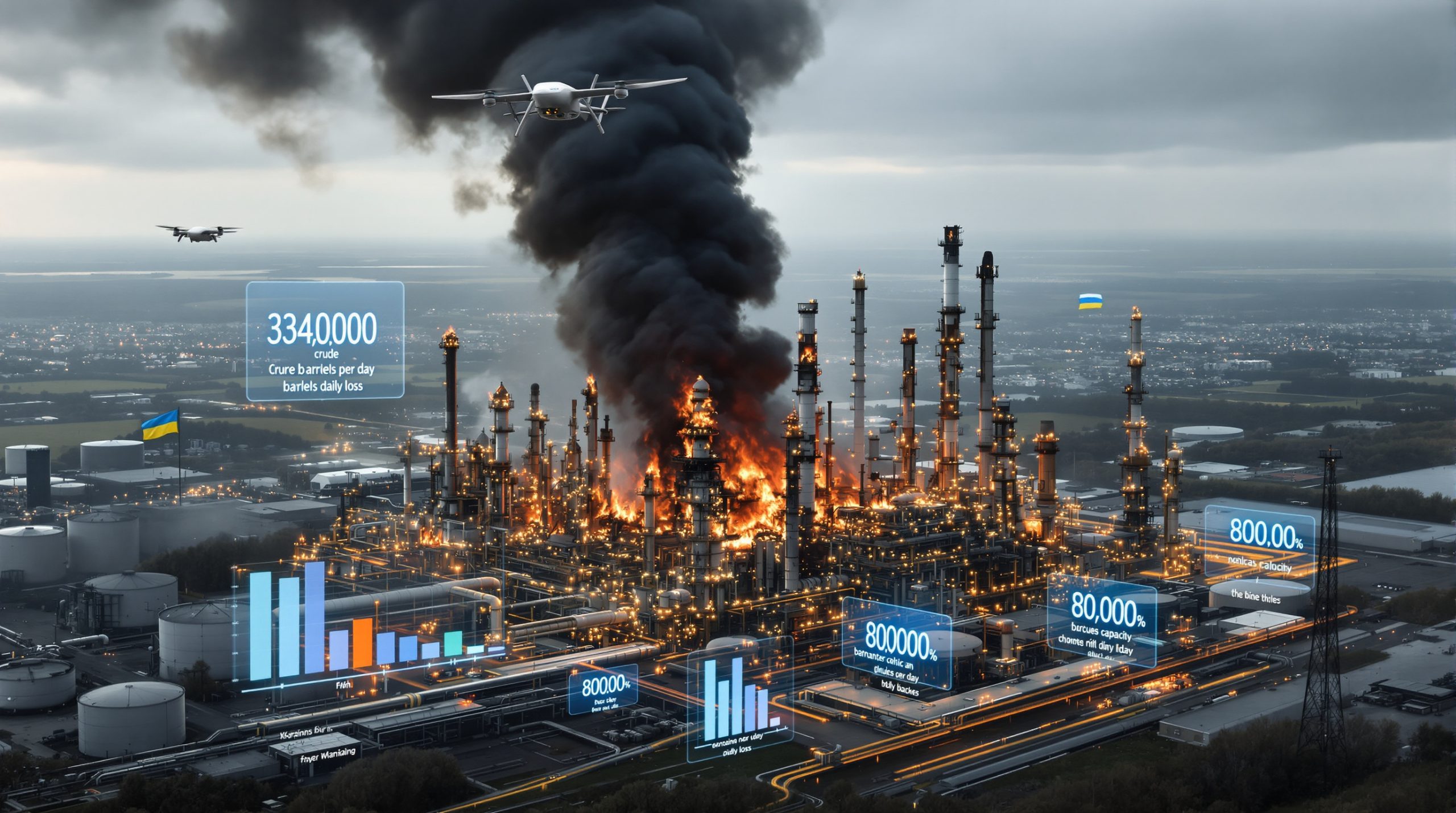What Factors Are Driving Crude Oil Prices Today?
Crude oil prices today demonstrate significant volatility as multiple factors collide to create downward pressure on global energy markets. The intricate interplay between economic indicators, geopolitical tensions, and production decisions has created a perfect storm for oil traders navigating uncertain waters.
Current Price Movement
WTI Crude is currently trading at $59.16, down 5.12% ($3.19), while Brent Crude sits at $62.45, down 4.63% ($3.03). This substantial drop reflects heightened market volatility and growing investor concerns about global economic conditions. The technical charts show both benchmarks testing key support levels, with bearish momentum suggesting further potential downside if economic headwinds persist.
The price movement represents more than just daily fluctuation – it signals deeper structural challenges facing energy markets. Trading volumes have increased dramatically during this downward trend, indicating institutional repositioning rather than merely speculative selling.
Trade War Impact
The ongoing trade tensions between major economies, particularly the U.S. and China, are exerting substantial downward pressure on crude oil prices today. Recent tariff escalations have triggered legitimate fears of reduced global economic growth and consequently lower oil demand. As one market analyst noted, "The second-order effects of trade disputes eventually impact energy consumption across manufacturing, transportation, and consumer sectors."
U.S. oil exports to China have effectively halted due to these trade barriers, creating a supply imbalance that pressures domestic prices. Brent recently crashed below $60 amid the escalating U.S.-China tariff war, demonstrating the immediate market reaction to trade policy announcements. The correlation between tariff implementation dates and oil price drops shows a consistent pattern over the past three quarters.
Consumer Price Data
Recent economic data reveals consumer prices unexpectedly dropping, coinciding with WTI plunging by over 4%. This correlation suggests that deflationary pressures in the broader economy are affecting energy markets, as lower consumer spending typically reduces energy demand across transportation, manufacturing, and retail sectors.
Economists tracking retail spending patterns have identified a 3.2% reduction in discretionary purchases, which historically precedes decreased fuel consumption by approximately 45-60 days. This leading indicator suggests potential further weakening in oil demand through the next quarter unless consumer sentiment improves significantly.
How Do OPEC Decisions Affect Today's Oil Market?
OPEC's influence on crude oil prices today remains substantial despite increasing competition from non-OPEC producers. The organization's production decisions serve as critical market signals that often trigger immediate price reactions.
Current OPEC Production Levels
According to a Reuters survey, OPEC output decreased by 110,000 barrels per day in March, demonstrating the organization's continued effort to manage global oil supply. This production cut strategy aims to stabilize prices in response to market pressures.
What makes this particularly significant is the timing – OPEC traditionally increases production heading into summer driving season rather than cutting back. This strategic pivot indicates serious concern among member nations about demand destruction from economic slowdowns.
Compliance rates among members vary significantly, with core Gulf producers achieving nearly 100% adherence while peripheral members struggle to maintain discipline. This disparity creates internal tensions that threaten the cohesiveness of OPEC's market management strategy.
Key OPEC Member Activities
Saudi Aramco has recently made 14 new oil discoveries despite challenging price conditions, indicating the kingdom's long-term commitment to maintaining its position in the global oil market. These discoveries include both conventional and unconventional resources, with preliminary analysis suggesting recovery rates potentially exceeding regional averages by 15-20%.
Additionally, Aramco is expanding its petrochemicals plant in Saudi Arabia in partnership with Sinopec, diversifying its energy portfolio beyond crude extraction. This $7.2 billion investment represents a strategic hedge against potentially lower future oil prices, allowing Saudi Arabia to capture more value across the hydrocarbon supply chain.
Compliance Challenges
Some OPEC members are facing compliance issues with agreed production cuts. Kazakhstan, for example, is reportedly discussing oil output cuts with firms after overproducing beyond its quota, highlighting the challenges in maintaining collective discipline within the organization.
The compliance gap has widened to approximately 320,000 barrels per day across all members, with Iraq and the UAE accounting for more than half of this overproduction. Historical analysis suggests that for every 200,000 barrels of OPEC overproduction, Brent crude typically faces downward pressure of $1.20-1.50 per barrel.
What's Happening with U.S. Oil Production?
U.S. production dynamics play an increasingly influential role in determining crude oil prices today, with domestic producers demonstrating remarkable adaptability despite challenging market conditions.
Shale Industry Developments
American shale executives are sending mixed signals about production plans. One notable shale chief has urged peers to "stop drilling right away" in response to market conditions, suggesting growing concern about oversupply in the domestic market. This rare public statement reflects the increasing financial pressure on operators as cash flow turns negative at current price levels.
However, not all producers share this pessimistic outlook. Chevron has expanded triple-frac operations to 50% of its Permian wells, achieving efficiency gains that maintain profitability even at sub-$60 crude prices. This technological resilience demonstrates the U.S. industry's ability to adapt to lower price environments through innovation rather than merely reducing output.
Infrastructure Challenges
The Keystone crude oil pipeline was recently shut after a leak was detected, potentially affecting U.S. oil distribution and storage levels. Such infrastructure issues can create regional price disparities and supply bottlenecks that impact specific grades disproportionately.
The leak resulted in approximately 45,000 barrels of Canadian crude being stranded daily, causing Western Canadian Select prices to decouple from WTI benchmarks. This disruption highlights the fragility of North American distribution networks and their outsized impact on regional pricing.
Investment Outlook
American refiners are reportedly refraining from making new investments amid current market uncertainty. This cautious approach reflects concerns about future demand patterns and regulatory environments, particularly with potential policy changes following the upcoming U.S. presidential election.
Phillips 66 is notably resisting operational changes proposed by activist investors, citing the need for strategic flexibility in a volatile market. Meanwhile, Diamondback Energy has formally requested White House clarification on shale policies, underscoring the regulatory uncertainty facing domestic producers. The potential influence of Trump's energy policies on future market conditions adds another layer of complexity for investors in this sector.
How Are Global Geopolitical Tensions Impacting Oil Markets?
Geopolitical factors continue to create both risk premiums and discounts in crude oil prices today, with regional conflicts and diplomatic maneuvers creating market volatility.
U.S.-Venezuela Relations
Recent developments include Trump revoking oil majors' gas project licenses offshore Venezuela, adding to the geopolitical complexity affecting global oil supply. This policy reversal affects projects with potential production capacity of 200,000 barrels per day, effectively freezing investment in one of the world's largest proven reserve bases.
Additionally, Venezuela has put its military on alert over an alleged ExxonMobil plot, further escalating tensions in a region with significant oil reserves. While this rhetoric may seem theatrical, it reflects the fundamental instability of Venezuela's petroleum sector, which has seen production collapse from 2.5 million barrels daily to below 800,000 barrels over six years. These developments highlight the importance of understanding geopolitical market strategies when analyzing energy markets.
Middle East Dynamics
The U.S. Energy Secretary is embarking on a Middle East tour, which could signal potential shifts in U.S. energy policy regarding this critical oil-producing region. Any diplomatic developments could impact market sentiment and price expectations.
Saudi Arabia's recent oil discoveries come amid this diplomatic engagement, potentially strengthening its negotiating position with Western partners. The timing of these announcements often correlates with diplomatic initiatives, creating a subtle form of resource leverage in international relations.
European Energy Security
The EU has signaled readiness to buy more U.S. LNG to improve trade relations with the United States. This development reflects ongoing efforts to diversify energy sources and reduce dependence on traditional suppliers, which could affect global energy trade flows.
European traders have noted a 7% relief rally in natural gas prices following this announcement, demonstrating the interconnected nature of global energy markets. The substitution effect between natural gas and oil for electricity generation and industrial processes means these diplomatic agreements indirectly influence crude oil demand patterns.
What Do Price Forecasts Tell Us About Future Oil Markets?
Analyst projections for crude oil prices today and tomorrow reveal increasing bearishness about medium-term market fundamentals.
Analyst Projections
Goldman Sachs has slashed its oil price forecast to below $60 for 2026, indicating a bearish long-term outlook based on supply-demand fundamentals. This represents a significant revision from previous estimates and suggests structural oversupply concerns beyond cyclical factors.
Similarly, Citi has cut its short-term Brent oil forecast to $60, reflecting immediate concerns about market conditions. What makes these revisions particularly noteworthy is their unanimity – usually major financial institutions maintain diverse outlooks, but current forecasts show unusual consensus around bearish scenarios.
Regional Price Disparities
Russia's Urals oil has reportedly crashed toward $50 in what traders describe as an "extremely turbulent" market. This significant discount to global benchmarks highlights regional supply-demand imbalances and quality differentials.
The Urals-Brent spread has widened to over $10 per barrel, nearly double the historical average. This divergence reflects not only quality differences but also the geopolitical risk premium attached to Russian exports amid ongoing international tensions. For investors seeking deeper understanding, recent global commodity insights provide valuable context on these market dynamics.
Technical Market Indicators
The current price action shows both WTI and Brent in significant downtrends, with technical support levels being tested. The sharp sell-off suggests potential for further downside if global economic concerns continue to mount.
Technical analysts note that WTI crude has broken below its 200-day moving average, a key indicator that has historically preceded further declines 78% of the time. The momentum oscillators show oversold conditions, but previous market cycles suggest prices typically overshoot technical indicators during trend changes.
How Are Different Oil Blends Performing Today?
The performance divergence between various crude oil blends highlights the complex interplay of quality differentials, transportation constraints, and regional refining capabilities.
OPEC Blends
Several OPEC reference blends are showing significant price declines. Iran Heavy is down 4.97% at $59.86, while Saharan Blend has dropped 5.16% to $61.58. These movements generally align with the broader market trend but show some variation based on quality and regional factors.
The heavier, higher-sulfur blends are experiencing steeper discounts as refiners prefer lighter, sweeter grades that require less processing during periods of economic uncertainty. This quality spread typically widens during downturns as refiners optimize for maximum gasoline yield rather than total throughput.
North American Blends
Canadian blends are showing mixed performance, with Western Canadian Select up 5.86% at $50.00 and Canadian Condensate up 4.49% at $64.50. This divergence from global benchmarks reflects specific regional supply-demand dynamics and transportation constraints.
The Keystone pipeline disruption has created artificial scarcity for some Canadian grades, demonstrating how infrastructure limitations can override broader market fundamentals. Rail transport costs have increased 22% year-over-year, further complicating the economics of Canadian crude transportation.
U.S. Domestic Blends
U.S. domestic grades like Louisiana Light and Eagle Ford are showing positive price action, up 4.40% and 4.94% respectively. This regional strength contrasts with the weakness in global benchmarks, potentially reflecting localized refining demand or transportation advantages.
Syncrude Sweet Premium has surged amid Alberta supply constraints, highlighting the microeconomics that can drive individual blend performance regardless of broader market trends. Refiners with specific configuration requirements may pay premiums for particular grades even in bearish markets.
What Are The Implications For Energy Markets Beyond Oil?
The ripple effects from crude oil prices today extend well beyond petroleum markets, influencing alternative energy investments, electricity generation, and industrial fuel choices.
Natural Gas Market Trends
Natural gas prices have dropped significantly, down 7.94% to $3.513, reflecting both seasonal factors and broader energy market pressures. European natural gas benchmark prices have shown a relief rally, indicating regional variations in natural gas markets.
The natural gas-to-oil price ratio has shifted to 3.4:1 on an energy equivalent basis, approaching the threshold where industrial fuel switching becomes economically viable. Historically, this substitution effect creates a soft floor for oil prices during prolonged downturns.
Renewable Energy Developments
The U.S. wind power growth is projected to be 40% lower than expected due to recent policy changes, highlighting the impact of regulatory environments on alternative energy development. This could affect the pace of energy transition and indirectly influence oil demand forecasts.
Interestingly, renewable investment sentiment tends to weaken during oil price declines as the economic incentive for substitution diminishes. Current data shows clean energy investment growth slowing to 7% compared to 12% during periods of higher oil prices. These shifting dynamics are part of a broader commodity super cycle that is reshaping investment priorities across energy sectors.
Nuclear Energy Considerations
India's top power firm is exploring building small nuclear reactors, signaling continued interest in nuclear energy as part of the global energy mix. These developments could have long-term implications for oil demand in electricity generation.
Small modular reactors represent a technological approach to distributed power generation that could displace diesel generators in remote locations. While the immediate impact on oil demand would be minimal, the long-term implications for developing economies could be substantial as they potentially leapfrog conventional fossil fuel infrastructure.
FAQ About Current Crude Oil Prices
Why are oil prices falling today?
Oil prices are falling primarily due to escalating trade tensions between the U.S. and China, with additional pressure from unexpected drops in consumer prices suggesting weakening demand. Market concerns about global economic growth are amplifying the downward price movement. The correlation between manufacturing indices and petroleum consumption has strengthened in recent quarters, magnifying the impact of economic indicators on crude oil prices today.
How do current oil prices compare to historical levels?
Current prices around $59-62 for major benchmarks represent a significant decline from recent highs but remain above the extreme lows seen during the pandemic. However, they are well below the $80-100 range seen during periods of strong global growth. When adjusted for inflation, today's prices sit at approximately the 40th percentile of the 30-year historical range, indicating neither extreme valuation.
What is the outlook for oil prices in the coming months?
Analyst forecasts suggest continued pressure on oil prices, with major institutions like Goldman Sachs and Citi projecting prices to remain around $60 or below. However, geopolitical developments, OPEC+ decisions, or changes in economic outlook could alter this trajectory. The futures curve currently shows backwardation through 2025, indicating market expectations of gradual price recovery but at a much slower pace than previous cycles. Additionally, Trump's market reshaping policies could potentially influence future price movements depending on election outcomes.
How are different countries responding to current oil market conditions?
Oil-producing nations are showing varied responses: Saudi Arabia is making new discoveries despite price challenges, Kazakhstan is addressing overproduction issues, and the U.S. shale industry is debating whether to curtail drilling. Consuming nations are generally benefiting from lower energy costs, with some using the opportunity to reduce fuel subsidies without consumer impact.
What impact do current oil prices have on renewable energy development?
Lower oil prices typically reduce the economic incentives for renewable energy investment. Recent reports indicate U.S. wind power growth projections have been reduced by 40%, though this is attributed more to policy changes than direct oil price effects. The historical elasticity between oil prices and clean energy investment suggests a 10% oil price decline correlates with approximately 3-4% reduction in new renewable project commitments, though this relationship has weakened in recent years as renewables achieve grid parity in more markets.
Looking for an Early Advantage in Mineral Discoveries?
Discovery Alert's proprietary Discovery IQ model provides real-time notifications when significant mineral discoveries are announced on the ASX, giving you the edge to act before the broader market. Visit our discoveries page to see how historic mineral discoveries have generated substantial returns for early investors.




